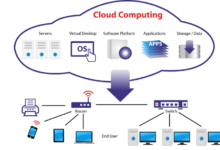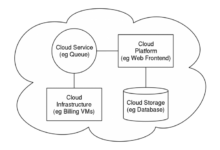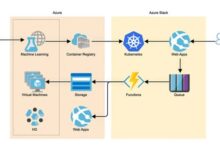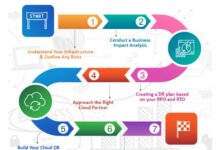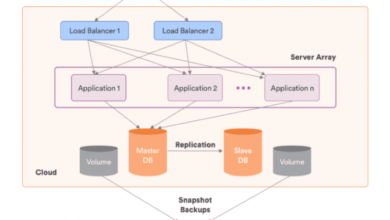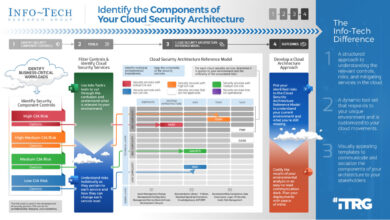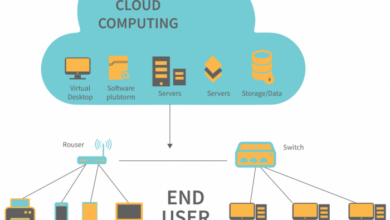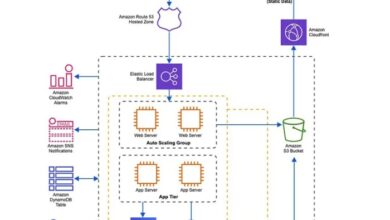Demystifying Application Modernization: A Journey Through Cloud Architecture Diagrams
In the ever-evolving landscape of technology, application modernization has emerged as a beacon of innovation, promising to transform legacy systems into agile, scalable, and cloud-ready solutions. At the heart of this transformation lies a powerful tool: cloud architecture diagrams. These visual representations serve as blueprints, guiding developers, architects, and stakeholders through the intricate complexities of modernizing applications for the cloud.
Cloud architecture diagrams are not mere illustrations; they are dynamic canvases that capture the essence of application modernization. They provide a shared language, enabling teams to communicate ideas, align on strategies, and navigate the challenges of cloud migration. Join us as we embark on a journey through these diagrams, deciphering their components, exploring design principles, and uncovering the secrets to creating effective visualizations that drive successful application modernization initiatives.
Introduction to Cloud Architecture Diagrams for Application Modernization
In the realm of application modernization, cloud architecture diagrams serve as invaluable tools that visually communicate the intricacies of cloud-based solutions. These diagrams play a pivotal role in bridging the gap between abstract concepts and tangible representations, enabling stakeholders to grasp the complexities of cloud architectures.
Visualizing cloud architectures through diagrams offers a plethora of benefits. They provide a shared understanding among team members, fostering collaboration and effective communication. Additionally, these diagrams facilitate informed decision-making by enabling stakeholders to assess various architectural options and their implications.
Purpose of Cloud Architecture Diagrams
Cloud architecture diagrams serve a multifaceted purpose in the context of application modernization. Primarily, they aim to:
- Provide a visual representation of the cloud-based solution, encompassing its components, interactions, and relationships.
- Communicate complex cloud architecture concepts in a simplified and accessible manner, catering to stakeholders with varying levels of technical expertise.
- Facilitate informed decision-making by enabling stakeholders to evaluate different architectural options and their implications, considering factors such as cost, scalability, security, and performance.
Types of Cloud Architecture Diagrams

Cloud architecture diagrams are visual representations of the components, relationships, and interactions within a cloud-based system. These diagrams help stakeholders understand the system’s architecture, identify potential issues, and make informed decisions about the system’s design and implementation. There are several types of cloud architecture diagrams commonly used for application modernization:
Logical Architecture Diagrams
Logical architecture diagrams provide a high-level overview of the system’s components and their relationships. These diagrams typically show the system’s functional components, such as application modules, data stores, and network components, and how they interact with each other. Logical architecture diagrams are useful for understanding the system’s overall structure and identifying potential areas for improvement.
Physical Architecture Diagrams
Physical architecture diagrams show the physical components of the system, such as servers, network devices, and storage devices, and how they are connected. These diagrams are useful for understanding the system’s infrastructure and identifying potential bottlenecks or points of failure.
Deployment Diagrams
Deployment diagrams show how the system’s components are deployed across different cloud platforms or environments. These diagrams are useful for understanding the system’s scalability and resilience and identifying potential issues with the system’s deployment.
Hybrid Cloud Diagrams
Hybrid cloud diagrams show how the system’s components are deployed across a combination of on-premises and cloud environments. These diagrams are useful for understanding the system’s integration with legacy systems and identifying potential issues with the system’s hybrid deployment.
Key Components of Cloud Architecture Diagrams
Cloud architecture diagrams for application modernization encompass essential components that represent the various elements involved in the modernization process. These components play crucial roles in ensuring the successful migration and transformation of applications to cloud environments.
Each component serves a specific purpose and contributes to the overall functionality and security of the modernized application.
Cloud Platforms
Cloud platforms, such as Amazon Web Services (AWS), Microsoft Azure, and Google Cloud Platform (GCP), provide the foundation for application modernization. They offer a comprehensive suite of services, including computing, storage, networking, and database services, that enable organizations to build, deploy, and manage applications in the cloud.
Application Components
Application components represent the individual modules or services that make up the application being modernized. These components can include web servers, application servers, databases, and other microservices. Each component has its own specific function and interacts with other components to deliver the overall functionality of the application.
Data Storage
Data storage components in cloud architecture diagrams encompass various types of storage services, such as relational databases, NoSQL databases, object storage, and file storage. These services provide persistent storage for application data and enable organizations to manage and access data efficiently in the cloud.
Networking Infrastructure
The networking infrastructure component in cloud architecture diagrams represents the virtual networks, subnets, and network connectivity options available in the cloud environment. It includes components such as virtual switches, routers, and load balancers, which facilitate communication between different components of the application and ensure reliable and scalable network connectivity.
Security Measures
Security measures are crucial components in cloud architecture diagrams for application modernization. They encompass various security controls and mechanisms, such as firewalls, intrusion detection systems, and encryption, that protect the application and its data from unauthorized access, cyber threats, and vulnerabilities.
Design Principles for Effective Cloud Architecture Diagrams
Effective cloud architecture diagrams serve as visual blueprints, aiding stakeholders in understanding and communicating complex application modernization journeys. To ensure their clarity, simplicity, consistency, and scalability, several fundamental design principles guide their creation.
Clarity and Simplicity
Clarity and simplicity are paramount in effective cloud architecture diagrams. Diagrams should convey information concisely and directly, avoiding unnecessary details and visual clutter. Key components, relationships, and data flows should be easily identifiable, enabling stakeholders to grasp the overall architecture at a glance.
Consistency
Consistency in visual representation and terminology is crucial for effective cloud architecture diagrams. Using standardized symbols, colors, and layouts enhances comprehension and facilitates comparisons between different diagrams. This consistency also aids in maintaining the diagram’s integrity over time, ensuring its continued usefulness.
Scalability
Cloud architecture diagrams should be designed to accommodate future growth and changes in the underlying architecture. Scalability ensures that the diagram remains relevant and informative as the application modernizes and evolves. This can be achieved through modular design, allowing for the addition or removal of components without compromising the diagram’s overall structure.
Flexibility and Adaptability
Cloud architecture diagrams should be flexible and adaptable to accommodate diverse stakeholder needs and perspectives. Different stakeholders may require different levels of detail and emphasis on specific aspects of the architecture. By providing multiple views or layers of information, diagrams can be tailored to meet the unique requirements of each stakeholder group.
Creating Cloud Architecture Diagrams
Creating cloud architecture diagrams for application modernization involves several steps to effectively communicate the architecture and its components.
Step 1: Gather Requirements
Begin by gathering requirements from stakeholders, including business objectives, application needs, performance goals, security concerns, and compliance regulations. This information forms the foundation for the architecture diagram.
Step 2: Select Appropriate Diagramming Tools
Choose a diagramming tool that suits the project’s complexity and the level of detail required. Consider tools that support cloud-specific symbols, templates, and collaboration features.
Step 3: Define the Scope and Boundaries
Clearly define the scope and boundaries of the architecture diagram. Determine which aspects of the application and infrastructure will be included and excluded. This helps focus the diagram and avoid unnecessary complexity.
Step 4: Identify Key Components and Relationships
Identify the key components of the modernized application architecture, such as application components, data stores, networking elements, and security mechanisms. Determine the relationships and interactions between these components.
Step 5: Create a Logical Architecture Diagram
Develop a logical architecture diagram that represents the high-level components and their relationships without specific implementation details. This diagram provides a conceptual overview of the architecture.
Step 6: Create a Physical Architecture Diagram
Create a physical architecture diagram that shows the actual deployment of components in the cloud environment. Include details such as cloud regions, availability zones, virtual machines, and network configurations.
Step 7: Document the Architecture
Document the architecture diagram with clear and concise explanations of each component, relationship, and design decision. Include annotations, legends, and a glossary to ensure easy understanding.
Step 8: Review and Iterate
Review the architecture diagram with stakeholders to gather feedback and identify any areas for improvement. Iterate on the diagram until it accurately represents the modernized application architecture.
Common Challenges in Cloud Architecture Diagramming

Creating cloud architecture diagrams often presents a range of challenges due to the complexity and dynamic nature of cloud environments. These challenges can hinder effective communication and understanding among stakeholders.
Addressing these challenges requires a combination of best practices, effective tools, and collaborative efforts to ensure accurate and comprehensive cloud architecture diagrams.
Managing Complexity
Cloud architectures often involve numerous components, services, and interconnections, leading to intricate diagrams. Managing this complexity is crucial for clarity and understanding.
- Simplify and Abstract: Focus on essential components and relationships, avoiding unnecessary details. Utilize abstraction techniques to group similar elements and highlight key concepts.
- Leverage Layering: Organize diagrams into logical layers, such as infrastructure, application, and data layers. This enables a structured and modular approach to diagramming.
- Use Standard Symbols and Notations: Employ industry-standard symbols and notations to ensure consistency and universal understanding. This facilitates collaboration and communication among diverse stakeholders.
Ensuring Accuracy
Accuracy is paramount in cloud architecture diagrams, as they serve as a foundation for decision-making and implementation.
- Validate and Verify: Continuously validate the accuracy of diagrams against actual cloud configurations. Regular reviews and updates are essential to maintain alignment with evolving architectures.
- Involve Subject Matter Experts: Engage cloud architects, engineers, and domain experts to provide input and feedback. Their knowledge ensures the diagrams accurately reflect the intended architecture.
- Utilize Automated Tools: Leverage diagramming tools with built-in validation capabilities to identify errors and inconsistencies. These tools can also assist in maintaining diagram accuracy over time.
Facilitating Collaboration
Effective cloud architecture diagrams foster collaboration and communication among stakeholders with diverse backgrounds and expertise.
- Use Collaborative Tools: Employ cloud-based diagramming tools that enable multiple users to work on diagrams simultaneously. This promotes real-time collaboration and facilitates discussions.
- Provide Context and Documentation: Include explanatory notes, annotations, and documentation to provide additional context and clarify the purpose and rationale behind design decisions.
- Conduct Regular Reviews: Schedule periodic reviews of cloud architecture diagrams with stakeholders to gather feedback, identify improvement areas, and ensure alignment with changing requirements.
Case Studies and Examples
Cloud architecture diagrams have played a pivotal role in the successful modernization of applications across various industries. Here are a few case studies and examples that showcase the impact of well-crafted diagrams in the modernization process:
Modernization of a Legacy Banking Application:
A large banking institution embarked on a journey to modernize its legacy core banking application. The existing system was monolithic, complex, and difficult to maintain. The modernization effort involved migrating the application to a cloud-native architecture, adopting microservices, and integrating with modern technologies.
To effectively communicate the modernization strategy and ensure alignment among stakeholders, the team created a comprehensive cloud architecture diagram. The diagram provided a visual representation of the new architecture, highlighting the key components, their interconnections, and the data flow. It also illustrated the migration approach and the timeline for each phase of the modernization process.
The cloud architecture diagram served as a valuable tool in facilitating discussions, addressing concerns, and gaining buy-in from stakeholders. It enabled the team to identify potential challenges and dependencies early on, ensuring a smooth and successful migration.
Digital Transformation of a Manufacturing Company:
A manufacturing company aimed to digitally transform its operations by leveraging cloud technologies. The transformation involved integrating various systems, such as production lines, inventory management, and customer relationship management (CRM), into a unified platform.
To visualize the complex integration and ensure seamless communication among stakeholders, the team developed a cloud architecture diagram. The diagram depicted the interconnected systems, data flow, and the underlying cloud infrastructure. It also highlighted the security measures and compliance requirements that needed to be addressed during the transformation process.
The cloud architecture diagram proved instrumental in aligning the efforts of different teams, ensuring that the integration was executed efficiently and effectively. It served as a roadmap for the digital transformation journey, guiding the company toward a successful outcome.
Future Trends in Cloud Architecture Diagramming
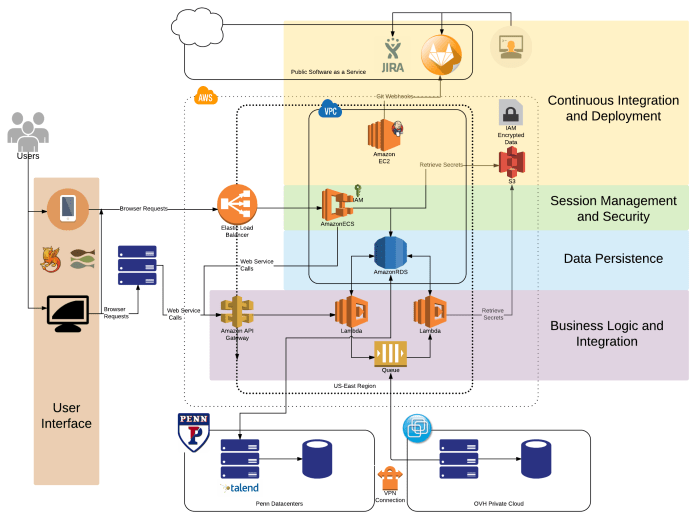
The field of cloud architecture diagramming is constantly evolving, driven by advancements in technology and changing business needs. Here are some emerging trends and innovations that are shaping the future of cloud architecture visualization and communication:
Real-time and Dynamic Diagrams
Cloud architecture diagrams are becoming more dynamic and responsive to changes in real-time. This allows architects and stakeholders to visualize and understand the current state of their cloud environment, including resource utilization, performance metrics, and security posture. Real-time diagrams enable proactive monitoring and troubleshooting, helping teams identify and resolve issues before they impact business operations.
Integration with Cloud Management Tools
Cloud architecture diagrams are increasingly integrated with cloud management tools and platforms. This integration allows architects and engineers to create and update diagrams directly from within their preferred cloud management environment. It eliminates the need for manual data entry and ensures that diagrams are always up-to-date with the latest configuration changes.
Artificial Intelligence and Machine Learning
Artificial intelligence (AI) and machine learning (ML) are being applied to cloud architecture diagramming to automate and improve the process of creating and maintaining diagrams. AI-powered tools can analyze cloud environments and automatically generate diagrams based on best practices and industry standards.
ML algorithms can identify patterns and trends in cloud usage, helping architects optimize their designs and make data-driven decisions.
Collaboration and Version Control
Cloud architecture diagrams are becoming more collaborative, with multiple stakeholders able to contribute and review diagrams in real-time. Version control systems are being integrated with diagramming tools, allowing teams to track changes, revert to previous versions, and maintain a history of diagram evolution.
Standardization and Interoperability
Efforts are underway to standardize cloud architecture diagramming notations and symbols. This will enable diagrams to be easily understood and interpreted by a wider range of stakeholders, including business leaders, IT professionals, and cloud providers. Interoperability between different diagramming tools is also being improved, allowing architects to easily import and export diagrams between different platforms.
Final Summary
As we conclude our exploration of cloud architecture diagrams for application modernization, it is evident that these visual representations are more than just technical artifacts; they are catalysts for innovation and transformation. They empower teams to envision the future, communicate complex concepts, and orchestrate successful migrations to the cloud.
As technology continues to evolve, so too will the sophistication and capabilities of these diagrams. The future holds endless possibilities for cloud architecture visualization, promising even more powerful tools to shape the digital landscape of tomorrow.
